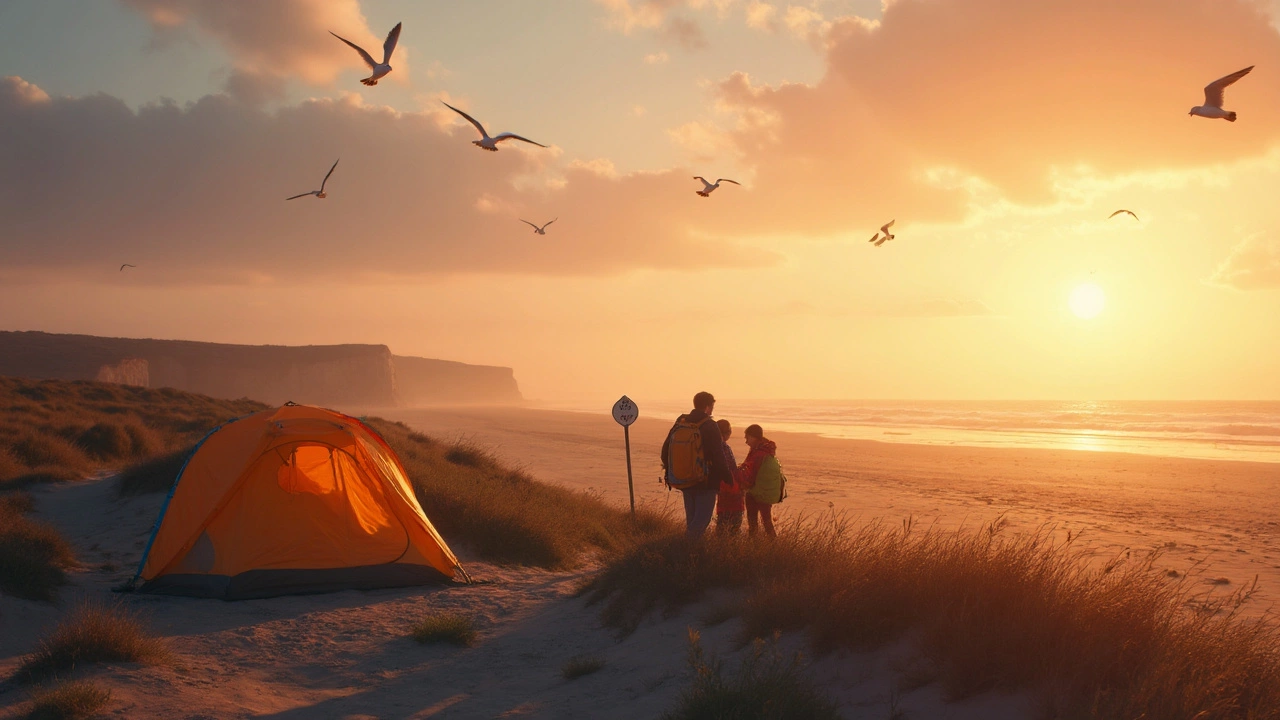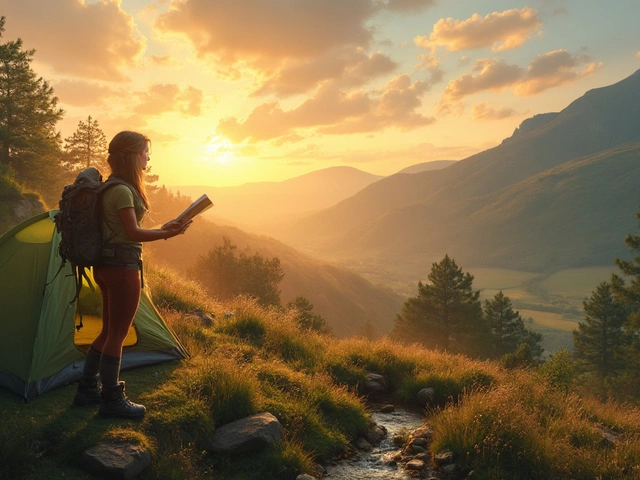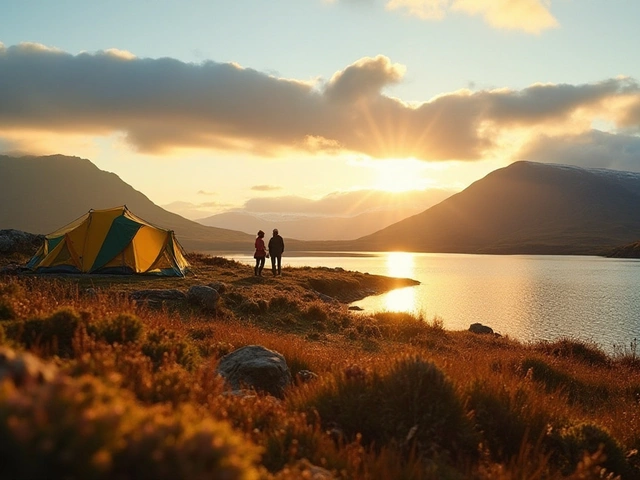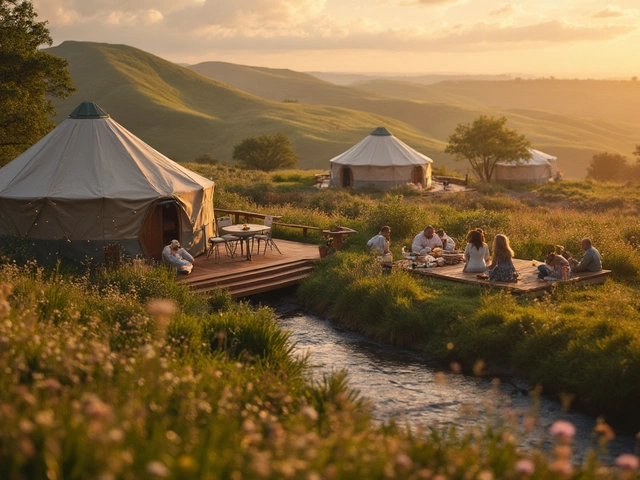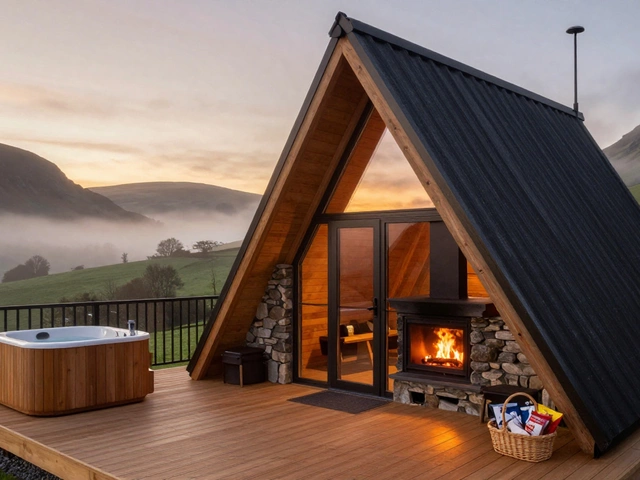Setting up a tent right on the sand sounds awesome, but you can get into trouble fast if you don’t check the rules first. Most public beaches in the US and Europe have strict regulations. Some allow overnight tent camping, but many ban it—or only allow it in tricky-to-find spots with permits. You can’t just roll up, pop your tent, and call it home for the night, even if it looks empty.
Parks, wildlife reserves, and city beaches each have different rules, and you’ll almost always see them posted near entrances. Skip the signs and you could score a hefty fine or a rude midnight wake-up from a ranger. It pays to double-check online for each beach’s camping policy or call up the park office. Honestly, a five-minute internet search has saved me and Aveline a lot of headaches when we travel with Rex.
Another tip—if you do get the green light to camp, remember beaches are public places. Things can change with the seasons, local festivals, fire restrictions, or even rare turtle nesting. Nothing ruins a chill beach night like having to pack up because you missed some obscure rule. So before you haul out your tent, do a quick rules check and trust me, you'll sleep way better.
- Beach Camping Laws and Permissions
- Scouting the Right Spot: Safety & Comfort
- Essential Gear and Setup Tips
- Dealing with Nature: Tides, Wildlife, and Weather
Beach Camping Laws and Permissions
If you’re dreaming of camping right on the sand, you’ve got to know the legal ropes first. Rules change from beach to beach, and they’re rarely just a suggestion—ignoring them can mess up your plans or your wallet.
Here’s what’s typical: public beaches run by towns or cities usually don’t allow overnight tent camping at all. National or state parks sometimes have special sections for tents but demand a permit in advance. On private beaches, you’ll need direct permission from the property owner or manager to set up—even a short afternoon nap under a tent can get you a trespassing ticket if you skip that step.
Campsites directly on the beach exist, but they aren’t everywhere. Spots like Padre Island National Seashore in Texas or California’s Leo Carrillo State Park are known exceptions, where beach camping is allowed with a permit. In Europe, places like Scotland are famously more relaxed (''freedom to roam'' laws let you wild camp almost anywhere), but Spain, Portugal, and Italy enforce strict bans on beach tents overnight. Here’s a quick look at how it actually plays out in popular locations:
| Beach/Country | Camping Allowed? | Permit Required? |
|---|---|---|
| Padre Island (USA) | Yes | Yes |
| California state beaches (USA) | Some | Yes |
| Scottish beaches (UK) | Yes | No (with rules) |
| France Mediterranean coast | No | — |
| Portugal/Spain beaches | No | — |
If you’re caught camping where it’s not allowed, you could pay a fine between $100 and $1,000 or even deal with police if you don’t pack up quick. Rarely worth the risk, honestly.
- Always check posted signs near beach entrances—rules can change seasonally or after storms.
- Don’t rely on random online forums for the latest info. Go to the official state, park, or tourism website. They update their rules after summer crowds, wildlife events, or local votes.
- Get paper or digital proof of your permit. Rangers and police don’t just take your word—especially during busy season.
It all comes down to this: before picking the perfect beach camping spot, you need to know the beach camping laws there. A little prep saves a world of hassle, and gives you a much better night at the shore.
Scouting the Right Spot: Safety & Comfort
Finding the perfect place to camp on a beach isn't just about stretching out for a sunset view. Your spot needs to be safe, allowed, and comfortable for sleeping. Before you even start dragging your tent through the sand, look for painted markers, signs, or faded stakes. These usually mark safe camplines and the areas where pitching a tent actually won’t get you fined or, worse, swept out by the tide.
Tide is your biggest natural enemy. Always check the local tide charts, which you can find online for pretty much any beach worldwide. Setting up too close to the high-tide line can mean a soggy tent and a mad scramble at 2 a.m. I once watched a couple’s gear float away because they camped below the obvious line of seaweed—definitely not a lesson you want to learn first-hand.
For comfort and safety, pick a flat spot above the high-tide mark. The easiest way to spot this? Look for dry, soft sand with no seaweed, driftwood, or trash, ideally with low dunes behind you as a windbreak. Avoid parking too close to a cliff or in front of dune grasses—these areas can hide wildlife burrows and sometimes are off-limits because of fragile plant life or erosion concerns.
- If the beach allows fires and you're planning to cook, scan for existing fire rings or cleared areas. Don’t just start one anywhere, since this gets a lot of campers in trouble.
- Steer clear of heavily trafficked paths and walking trails, so you’re not in anyone’s way or up all night as folks stroll past your tent.
- Think about wind direction. Sandstorms aren’t just desert fiction; one gusty evening can fill your tent and even your food with grit. Set up with your tent’s door facing away from the wind if you can.
Some beaches even post data on average temperatures, wind, and risk zones. Here’s an example using numbers from a popular California state beach:
| Factor | Safe Range / Zone | How Often It Changes |
|---|---|---|
| High Tide Mark | At least 8-10 meters from current shoreline | Every 6-12 hours |
| Wind Speed (evenings) | Up to 20 mph; above that, seek shelter | Daily |
| Wildlife Nesting Zones | Clearly marked, usually roped off | Seasonal |
If you remember nothing else, just stay far back from the water’s edge and respect marked boundaries. A great beach camping night really comes down to simple prep—check tidal info, scan for wildlife warnings, and settle in above the high-tide line out of the wind. You’ll thank yourself later.
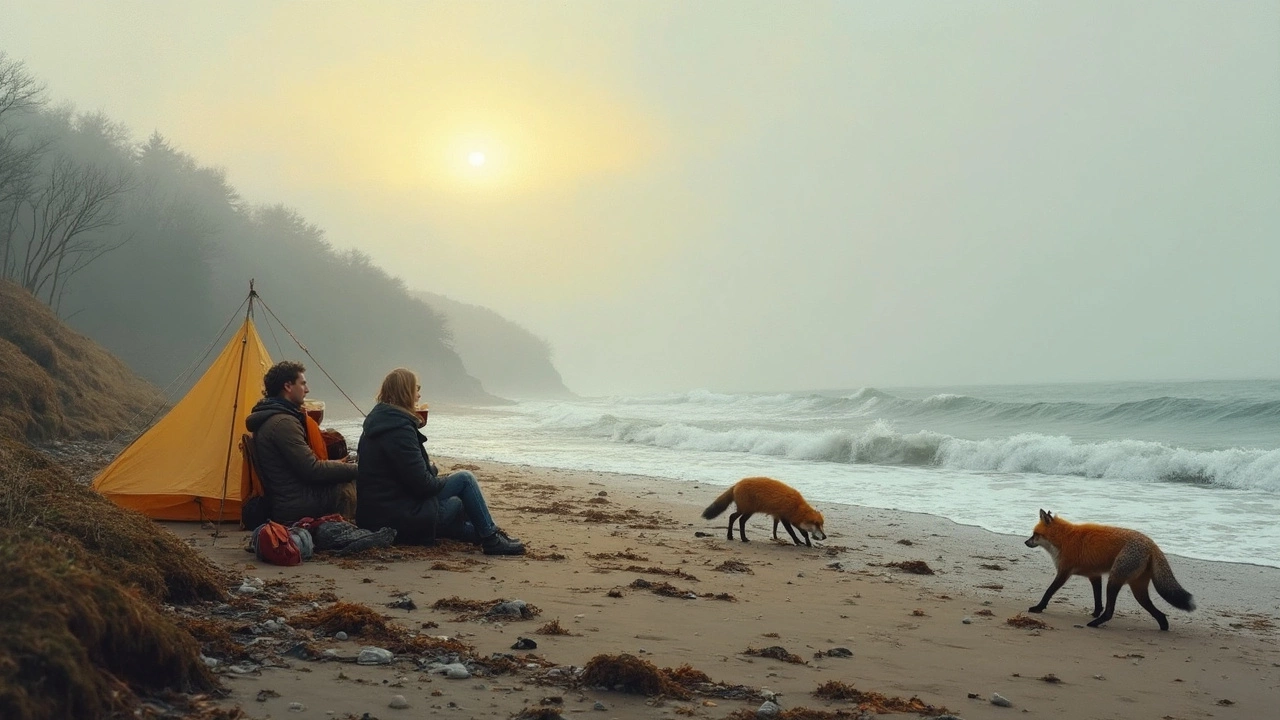
Essential Gear and Setup Tips
You don’t need fluffy gear catalogs, but there’s stuff you simply can’t skip for beach camping. First up: your tent. Regular tents work, but the wind at the coast is a whole other beast. Look for one with low, aerodynamic walls and tons of anchor points—otherwise you’ll spend the night chasing your tent down the shore. Sand stakes or screw-in pegs actually hold in the soft stuff; normal stakes pop out with one good gust.
Bring a sand mat or a ground tarp. Sand finds its way everywhere, and a groundsheet with a tight weave is a lifesaver for keeping your sleeping bag and snacks grit-free. Go for a sleeping pad or inflatable mattress instead of a thin foam mat. Sand gets hard and cold at night, even when it’s hot during the day. If you’ve ever woken up with a sore back after a night on the beach, you know what I mean.
Lights are a must. Flashlights, headlamps, and a couple of small LED lanterns work way better than relying on your phone’s flashlight. And if you’re cooking, pick a camping stove instead of hoping for a bonfire—that’s banned on a lot of beaches and those salty breezes make open fires way less fun.
- Sand stakes or screw-in pegs for tents
- Lightweight, low-profile tent with multiple anchor points
- Sand mat or tightly-woven tarp
- Inflatable sleeping pad or mattress
- Headlamps and lanterns (LED; battery or solar powered)
- Camping stove and windscreen
- Extra water—saltwater is useless for drinking or cooking
- Zip-top bags or dry sacks for keeping food and electronics sand-free
- Quick-dry clothes and towel
- Bug spray (mosquitoes are real, even on windy beaches)
Here’s a quick look at the most-forgotten gear and why you need it:
| Item | Why It's Essential |
|---|---|
| Sand stakes | Hold your tent in place; regular stakes just don’t grip |
| Portable shade (beach umbrella or tarp) | Protects from sunburn during day and adds privacy |
| Dry bags | Keeps electronics and snacks safe from sand/water |
| Extra water | No freshwater on most beaches |
I always pack double the water I think I’ll need. Sounds dramatic, but salt and sun suck the hydration right out of you. And if you’re bringing a dog like Rex, that goes double. Make a checklist before you leave; forgetting even one thing can turn an adventure into a slog. Set up your tent away from the water line, anchor it well, and you’ll actually get to relax instead of fighting off the next gust or unexpected wave.
Dealing with Nature: Tides, Wildlife, and Weather
The beach looks chill, but nature can mess up your plans fast. First thing, always check tidal charts. Setting up your tent where the sand feels flat and open might put you right where the high tide will roll in at 3 a.m. Every year, emergency crews get called out for campers trapped by rising water. If you want a safe spot, pitch your tent above the last high tide line, which is usually marked by a row of dry seaweed or shells.
Wildlife is another thing you can't ignore. At some beaches, raccoons, gulls, or even wild hogs will raid your camp looking for snacks, so keep your food in sealed containers. In Florida, I've seen campers lose their breakfast to bold herons and sneaky crabs. If you’re camping on the West Coast or Gulf beaches between May and October, watch out for sea turtle nests. It’s illegal to set up too close, and the fines can be steep.
Weather can turn a peaceful camp into a muddy mess, too. Summer storms hit fast. Heavy winds can collapse most lightweight tents if you don’t use sand stakes or bags. Beach weather is weird—morning sun, afternoon wind, chilly evenings. That means bring layers and always stake your tent down tight. The biggest rookie mistake is not anchoring the tent deep enough. Those standard metal pegs barely work in soft sand—instead, use sand anchors or bury sturdy stuff sacks filled with sand as DIY anchors.
Watch these major risks before pitching your tent:
- Tides: Know when the highest tide hits, so your tent doesn’t get soaked.
- Wildlife: Don’t leave food or trash out unless you want unexpected visitors.
- Storms: Heavy wind and rain can wreck your camp in minutes if you’re not ready.
Here’s a simple cheat-sheet for key nature factors when beach camping:
| Factor | What to Check | When to Worry |
|---|---|---|
| Tide | Local tidal chart or app | Before setting up tent |
| Wildlife | Ask locals/rangers, look for signs | Overnight, food storage |
| Weather | Weather app, wind predictions | Before and during your trip |
One last thing—pack a flashlight and always have your shoes handy. Some beaches are crawling with sand fleas or spiky shells at night, and you don’t want a sharp surprise on your way to the water.
